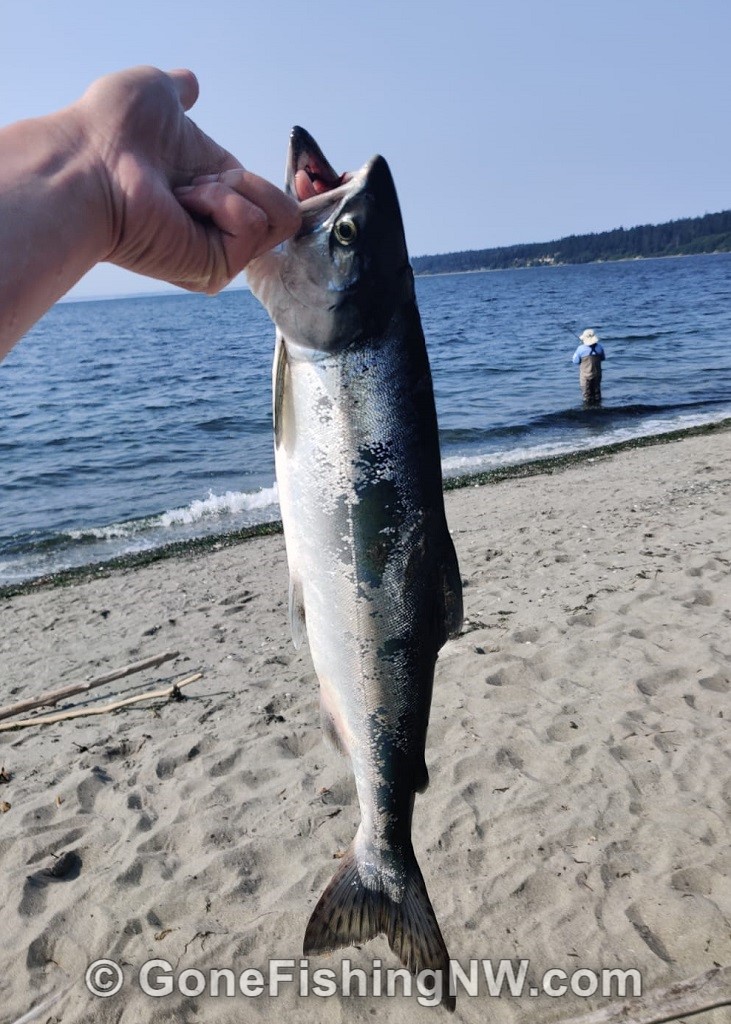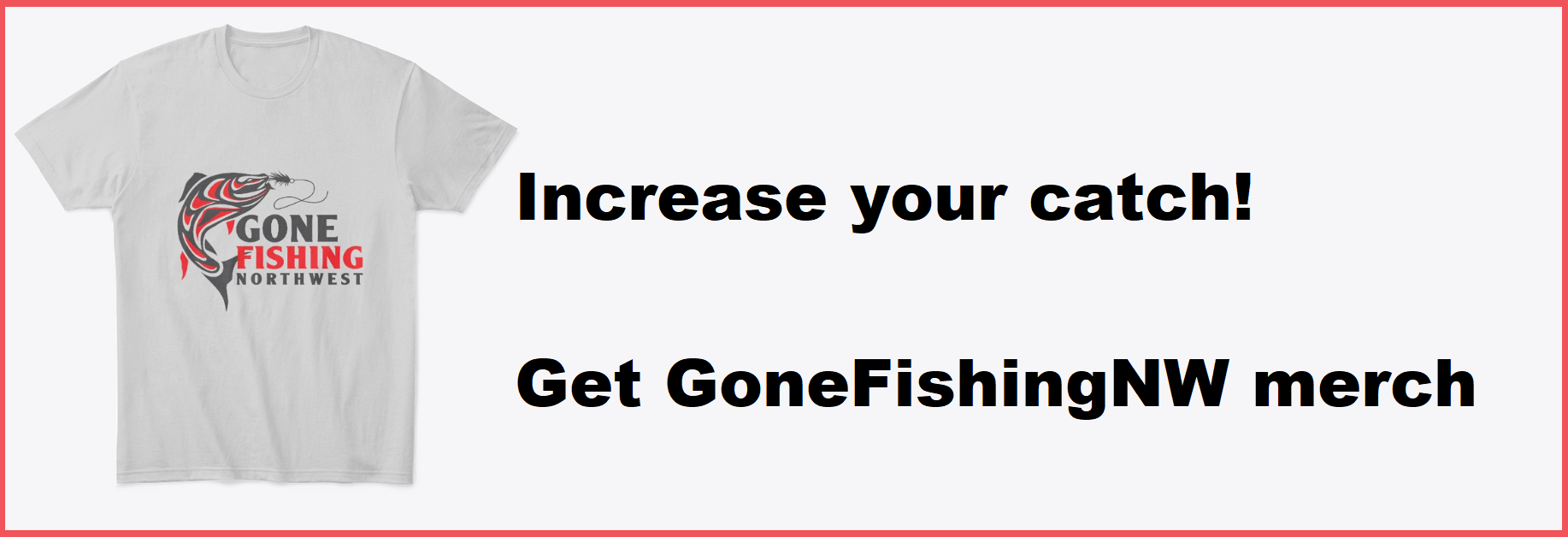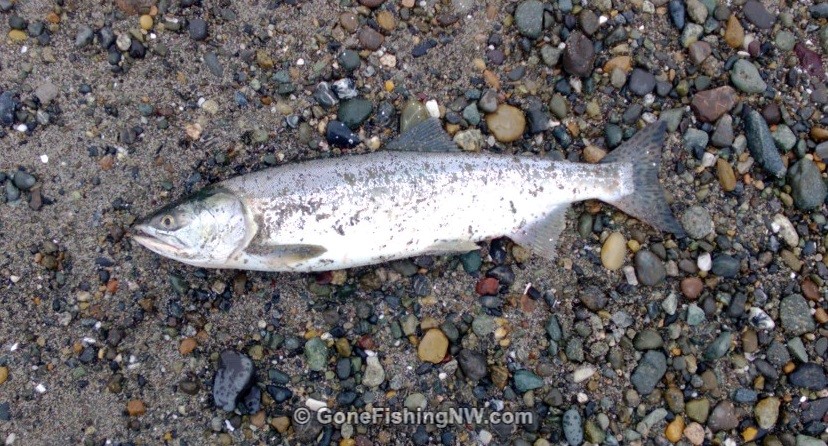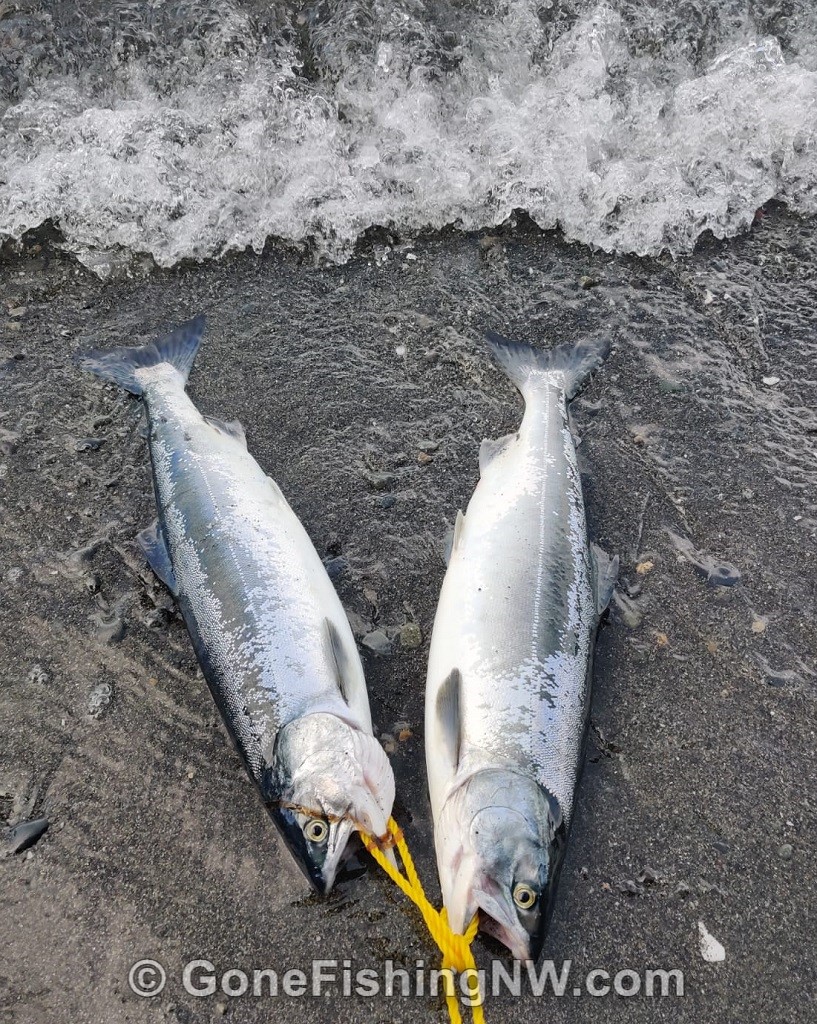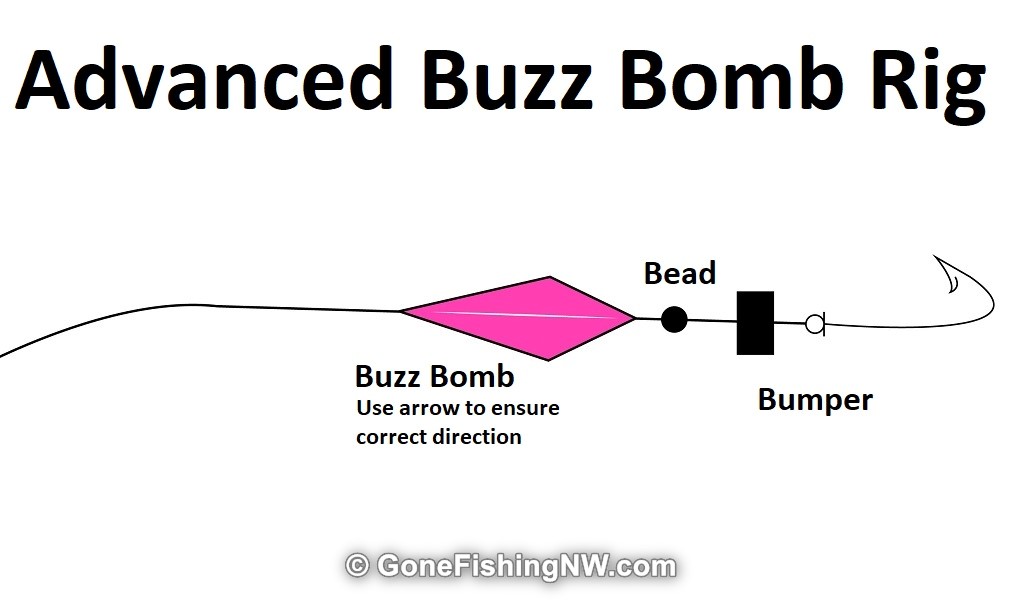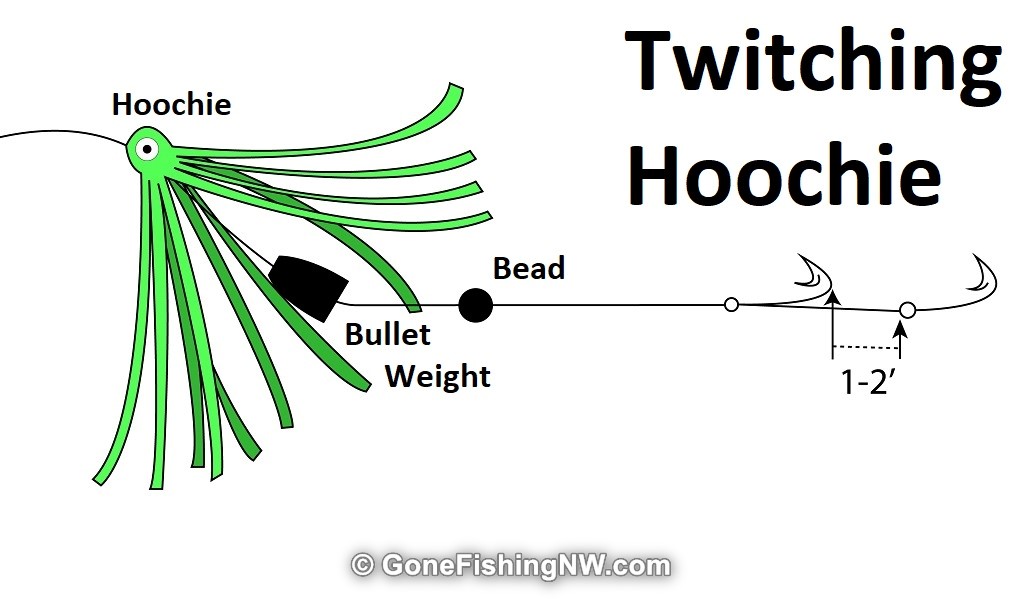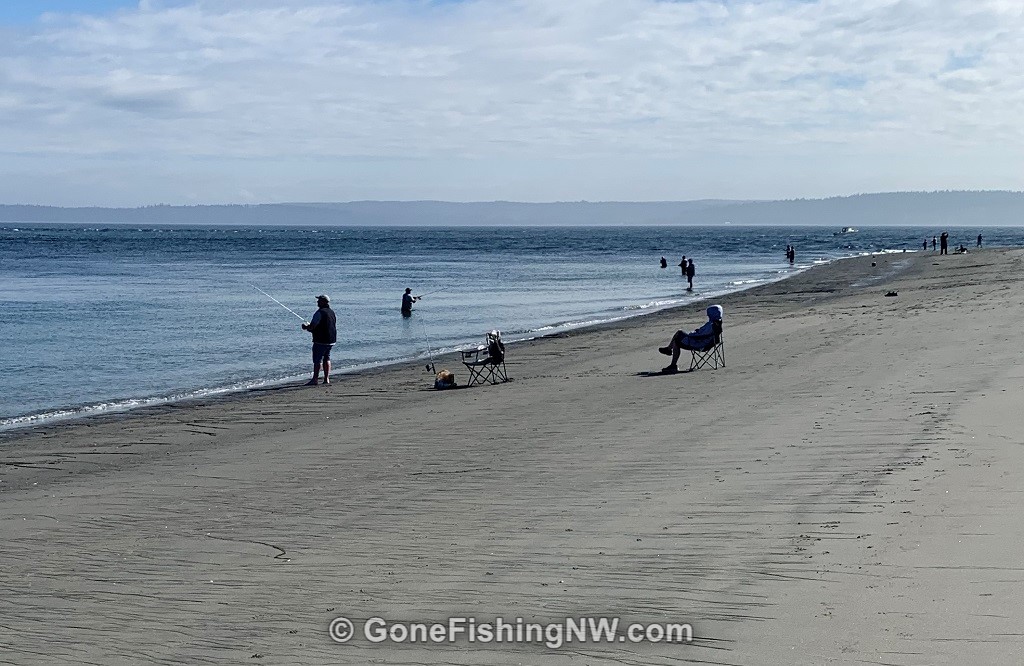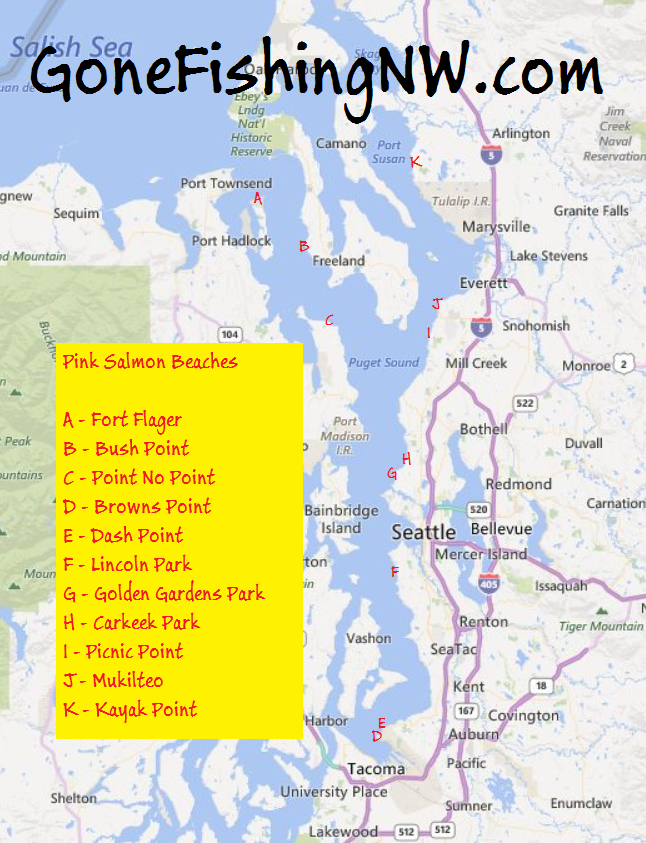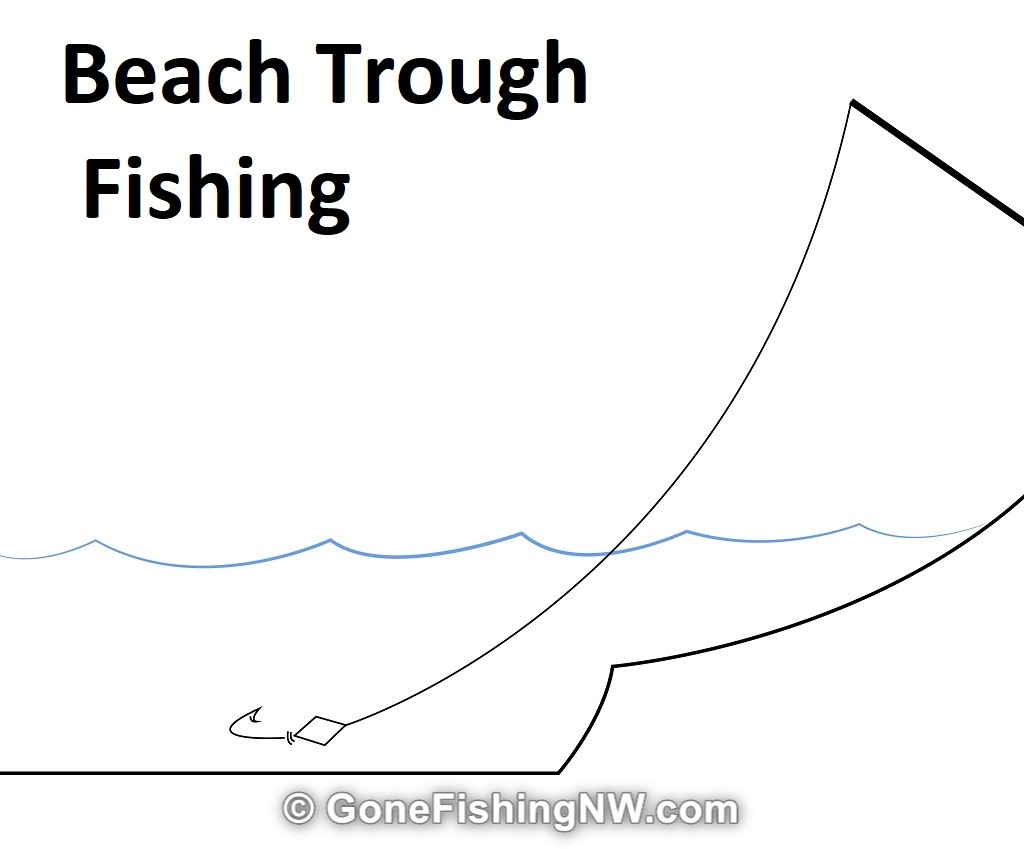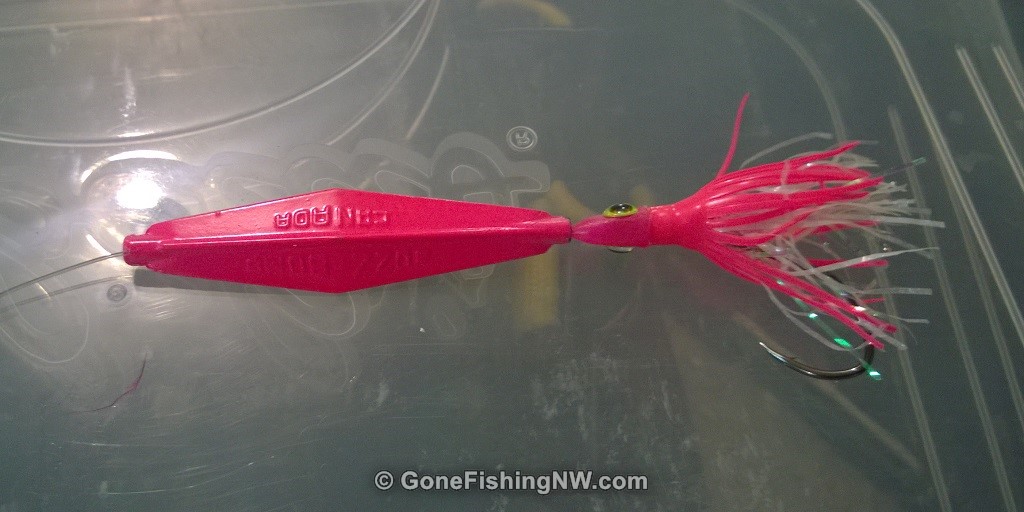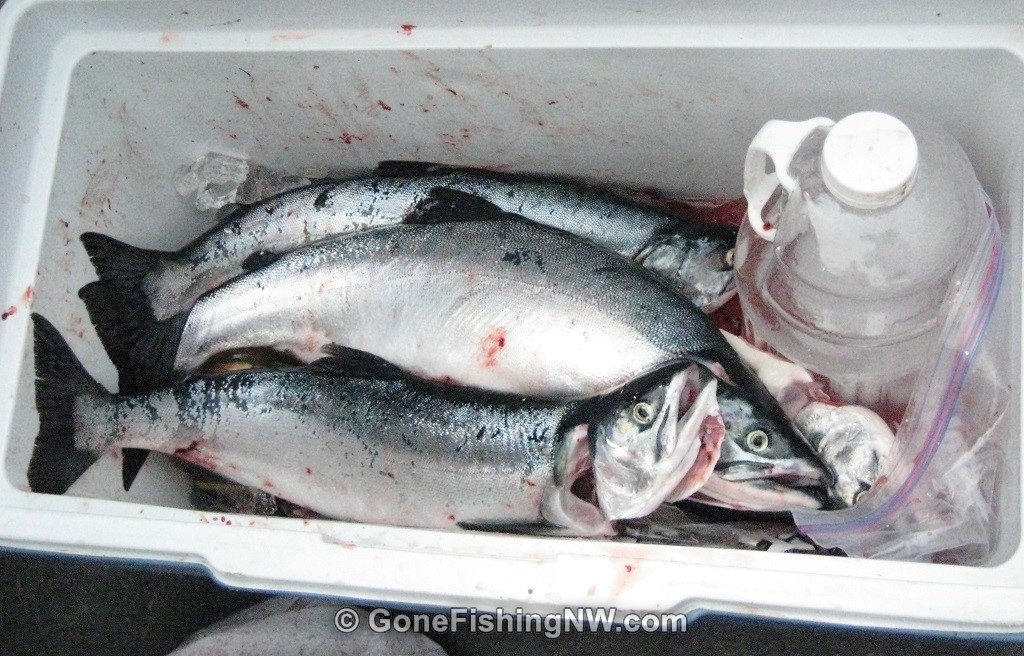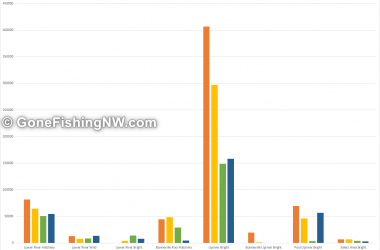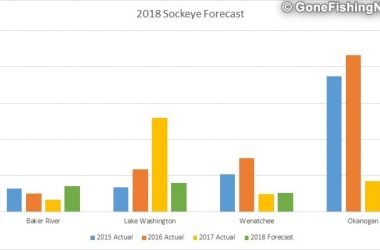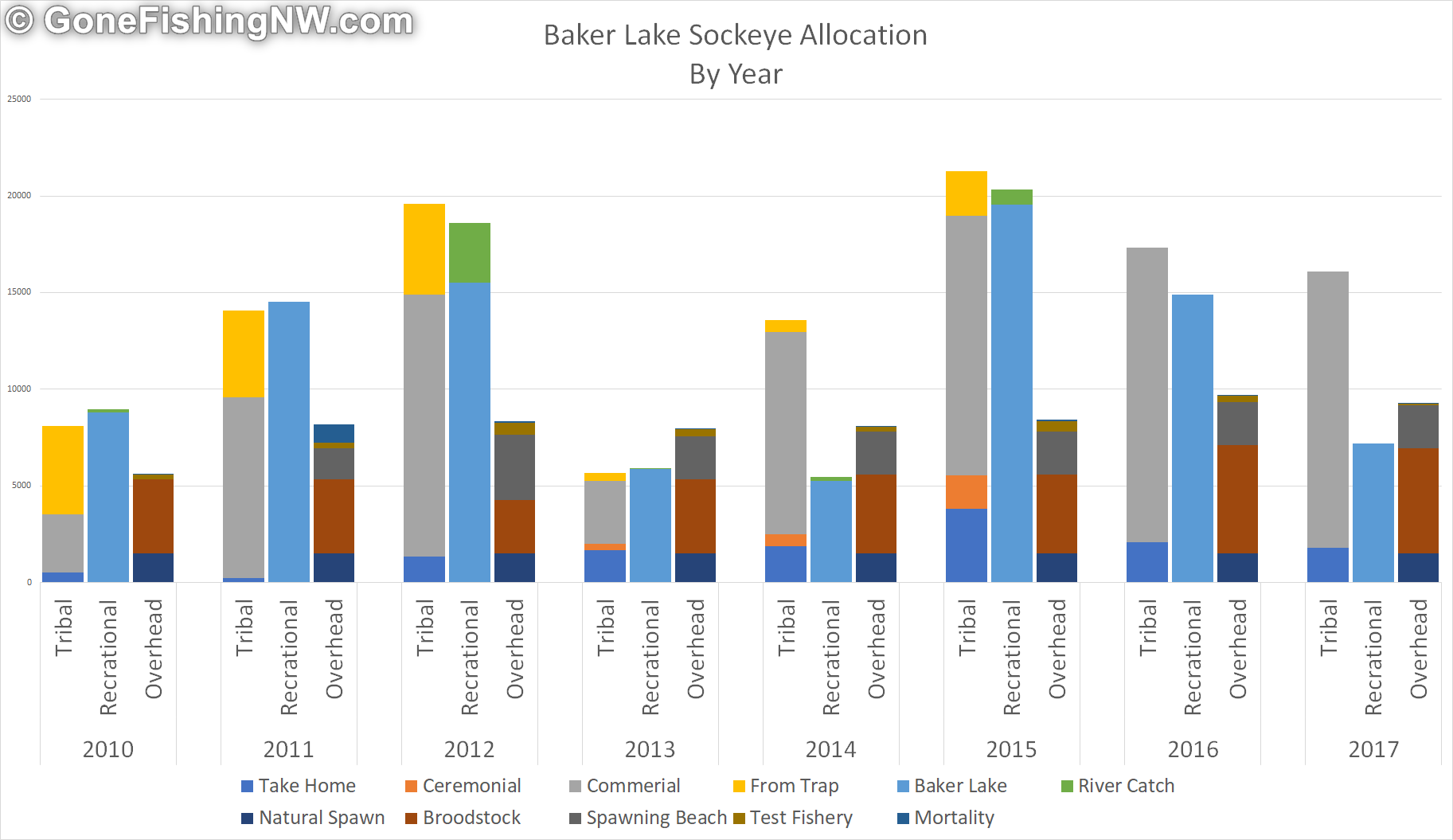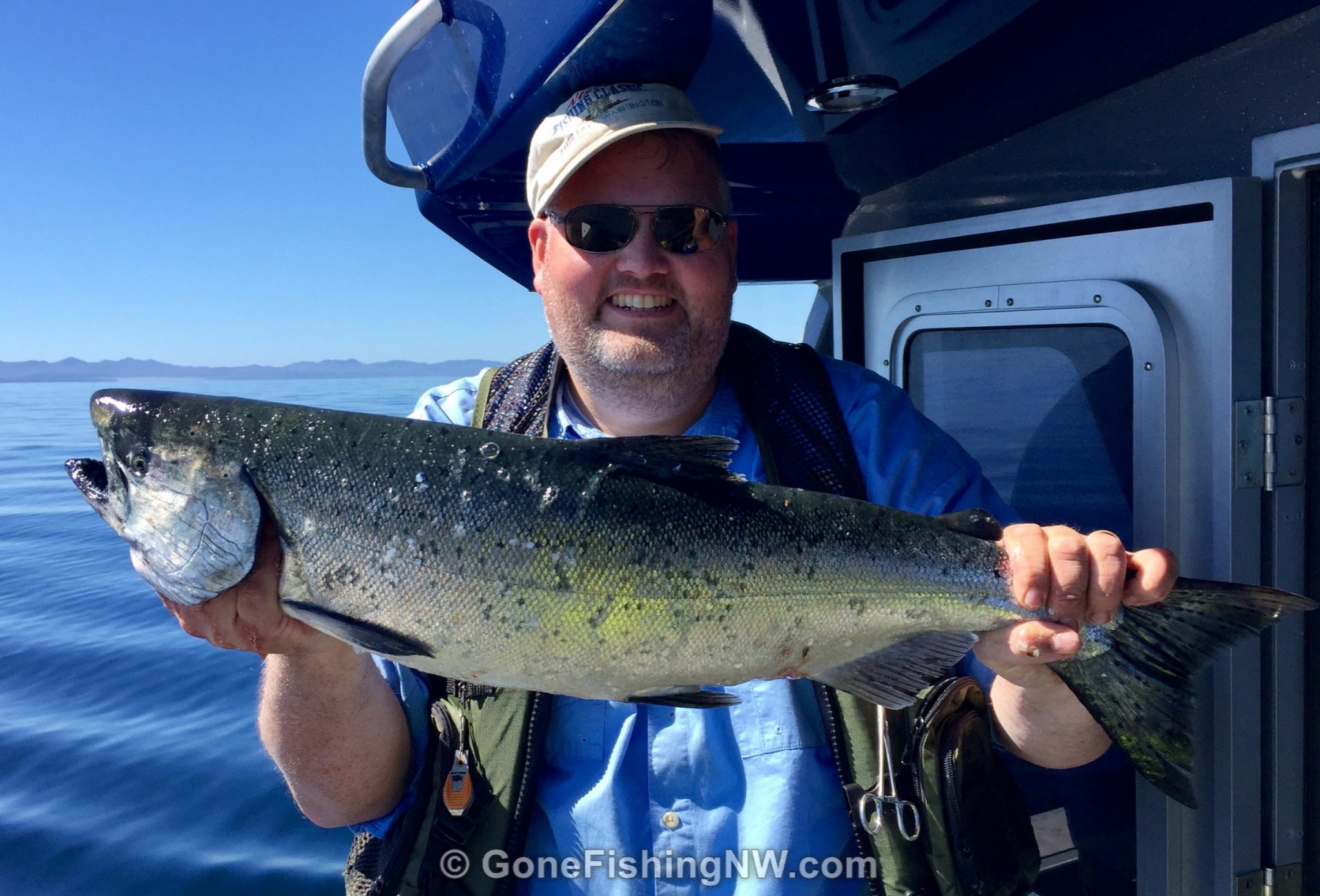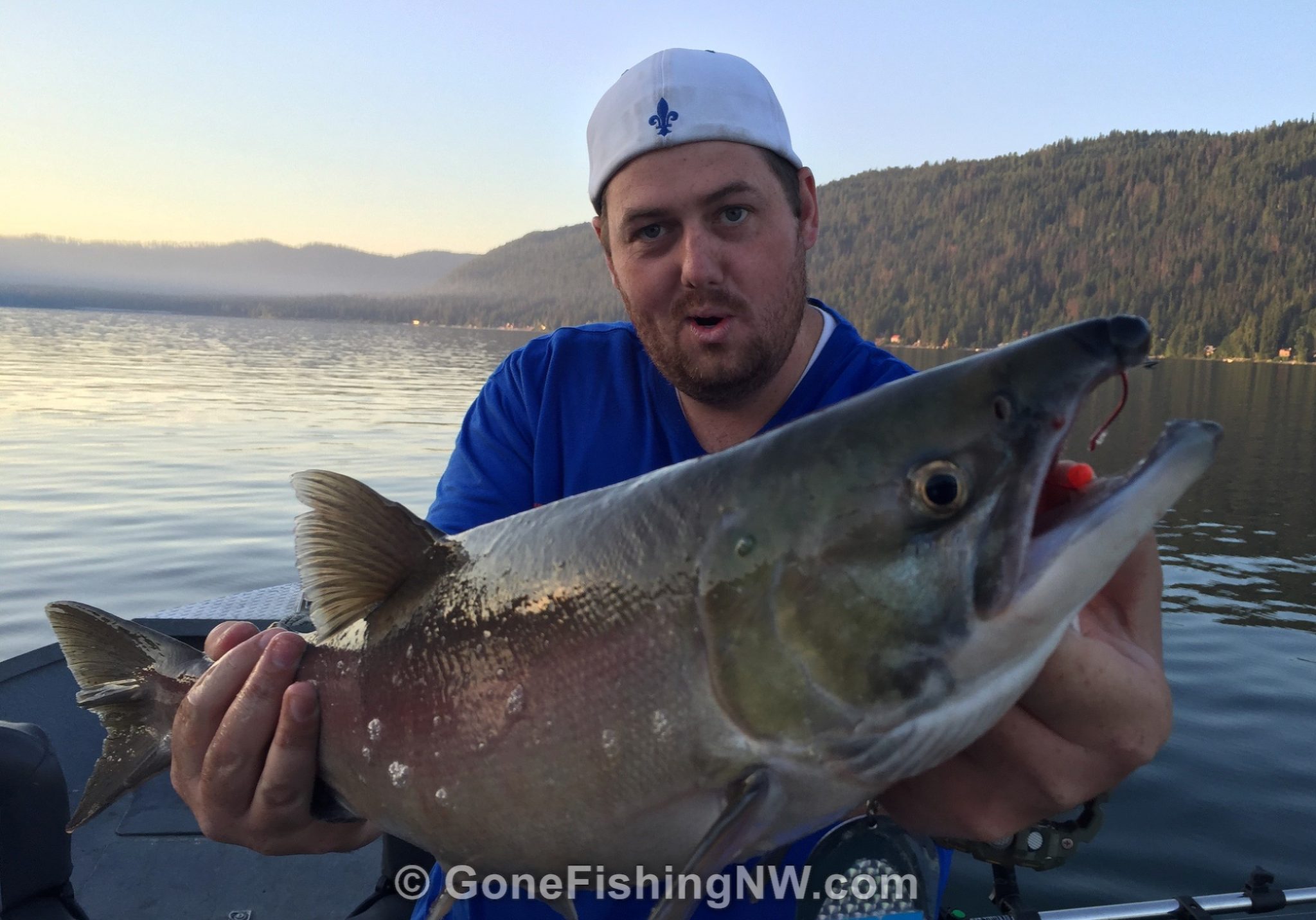In this article I’m going teach you all about how to catch pink salmon from the beach, especially around Puget Sound. You will learn about the life and behavior of pink salmon, the best gear to use, how to pick where to fish, techniques to catch, and how to preserve and cook your catch. Even if you are an experienced angler, you will likely pick up a few new tips.
About Pink Salmon
Pink salmon are the smallest species of Pacific salmon and are very popular with recreational anglers. They are also called “humpies” due to the large hump the male develops on his back during spawning time.
You may be wondering why they are so popular if they are the smallest species. The reason is that they are the most abundant salmon species, so while the returns of most salmon species in Washington state are measured in the thousands – pink salmon are measured in the hundreds of thousands and sometimes even millions.
In the United States the native range is from Alaska down to the Sacramento River in California. They also live and spawn on the other side of the Pacific in Russia. Since then they have been introduced to other areas, like the Great Lakes.
After the little salmon hatch from the egg they soon migrate out to the ocean – which makes them less susceptible to unfavorable river conditions. Out at sea they travel in large schools and primarily eat plankton. In this stage of life they are silver with black mouths and large spots on the tail. This is very similar to how saltwater chinook look – sometimes a cause of misidentification.
Pinks have a strict 2 year life cycle – unlikely other species which have greater differentiation. This leads to limited interbreeding between runs that spawn in odd years vs even years. Many people don’t realize there is an even year run on pinks because it is so small in number that to catch one is rare. Odd years, are quite different when they can return to Puget Sound in the millions.
As pinks enter freshwater and get close to spawning the look changes – the belly becomes white and the top is a pale grey with an overall dull green color. Males develop a pronounced hump on their back – earning them the name “Humpies” or “Humpy Salmon. Males also develop a kype – or hooked nose.
Pinks are the smallest of the salmon species with adults averaging around 4 pounds. However occasionally much larger ones are caught. The state record for Washington state is 15.4 pounds.
The Pacific Northwest range for salmon stretches from Alaska to the Sacramento river in California. However, California runs are listed as endangered and Oregon rivers do not get a significant number of them. As far as I’m aware Puget Sound rivers are the largest pink salmon runs south of Canada – at least for odd year runs.
For their size pink salmon are hard fighters, and can have entertaining jumps.
Gearing Up
When fishing off the beach it is important to have the right rod and reel. While you could use anything, the right rod will let you cast the lure to the fish and give you a good hookset.
Since you will be doing a lot of cast and retrieve a spinning reel works best for most people – both for ease of use and casting distance. My recommendation is a Pflueger President in size 30 or 35, or a Shimano Sedona 2500 size. If you have the budget and want a high end reel that will last a lifetime then the Shimano Stratic is a good choice.
The ideal rod to pair this with is one that is 9 to 10 feet long, has fast action and has a medium-light strength. A true medium-light rod will be marked as ideal for 6-10 pound line, and 1/4-1/2 ounce lures. A good price/performance rod is the Fenwick Eagle. For a budget option the Ugly Stick GX2 is a good choice. If you want high end then a G Loomis fast action side drifting rod, like the IMX 1162-2S or IMX 1102-2S.
15 pound Maxima Ultragreen is my line of choice when it comes to using mono line. If you prefer braid then PowerPro moss green 30 pound line is my favorite. If you are wondering why the braid strength is higher than the mono, it is because when going with braid what tends to be the deciding factor is the line diameter. The larger diameter is easier to work with, and is still smaller and stronger than the mono. If going the braid route remember to first put on about 10 feet of mono to ensure enough grip so the line doesn’t slide on the spool. For leader material I like Seagar fluorocarbon in 15 pound strength.
Tackle
For tackle the classic beach fishing lure is a pink buzz bomb. Most people use ones in the size range of 1.5” to 2.5”. As a general rule I recommend using the smallest size which allows you to cast the distance you want. When rigging a buzz bomb be sure to run the line correctly through it – an arrow on the lure tells you the direction. This will ensure proper flutter of the lure. Next slide on a bead and then the rubber bumber. The bumber protects the knot on the hook from the lure hitting it over and over. The bead keeps friction on the lure to a minimum to get good flutter. Lastly tie your hook on, using your favorite knot.
Other lures which work well are a twitching jig, twitching hoochie and minnow jigs. You would fish these in similar to the buzz bombs, and should stick in that same general weight range of 1/2 oz to 1oz. Fluorescent pink is the classic color to use, but other colors like chartreuse or silver can work as well. Details on how to tie up a twitching hoochie are below.
I typically rig these lures up with about a 3 feet leader and a small swivel to keep any twist from creeping into the mainline.
Many lures come standard with treble hooks. If you need to change it due to personal preference or regulation reasons then I suggest using an Octopus hook if the hook ties to the leader, or a siwash hook if it attaches to the lure. Generally speaking a size 2/0 to 4/0 work fine. If replacing a treble hook then the rule of thumb is the single hook should have roughly the same width as the treble.
Making a Twitching Hoochie
Twitching hoochies are effective, but aren’t a commercial lure you’ll find in a store, so you will need to tie it yourself.
Start with a length of leader, make it roughly half a foot longer than you’ll want the finished setup. Remember it is a lot easier to cut something shorter than make it longer later.
Then tie on 2 octopus hooks. I like using the Egg Loop knot. Space the hooks at least 1 inch apart, but no longer than inches.
Then slide on a small bead, and worm weight (pointy end away from the hooks).
Lastly slide down the hoochie. The worm weight should fit right in the head of the hoochie, and the bead keeping it from sliding over the hook.
Clothing and Other Gear
You’ll want to arrive at the beach prepared to get at least a little bit in the water. You can use waders, but rubber boots work in most circumstance too. Given the nice summer weather shorts and sandals or water shoes work well too. Don’t forget sunglasses, a hat and some sun screen.
Select The Perfect Beach
Now that you are all geared up and ready to hit the water you just need to find that perfect beach. You, of course, want a beach that is accessible and public access is allowed. So start your search looking at beaches near parks, boat launches and other public places.
The ideal pink salmon fishing beach will have a few characteristics. First it is a point that juts at least a little into the ocean – what will cause fish to be close to shore. The water depth should drop down relatively quickly. A tidal flat that is just a couple feet deep for a hundred yards out isn’t a good spot. The tides will also impact how fishable a beach is – some beaches are best fished at low tide, and others at high tide.
I suggest visiting a beach at different tide levels to determine when it is fishable. It is good to note such things in your fishing journal so you can remember that information for later. I keep my fishing journal in a cloud drive location. This allows me to access it from a variety of devices, including my phone when I’m out fishing – assuming I have a good signal, of course.
Some Puget Sound area beaches which are popular spots for fishing for pink salmon include:
- Bush Point
- Point No Point
- Browns Point
- Dash Point
- Fort Flagger
- Picnic Point
- Kayak Point
- Mukilteo boat launch
Cast and Retrieve
Now that you are at the beach, how do you actually fish it? Start by walking to the edge of the water. Most of the time you can stand out of the water, but occasionally you may find it helpful to walk out a few feet to get that extra casting distance.
Cast your lure straight out into the water. Count down a few seconds to give the lure time to sink close to bottom. Then do a quick jerk of the rod. The rod tip should move about 1 foot. Bring the rod back down so the line has slack and allow the lure to drop again. Occasionally reel the line in a turn or so.
The fish will hit the lure while it is falling, so you don’t want to wait too long between jig jerks.
When the lure is out of position, either by being brought back into the shallow water or current moving it sideways, reel it all the way in and cast back out.
When you get a bite give it a good hookset and start fighting it in. Typically you don’t need to muck around with a net, just take several steps back from the water and drag the fish out of the serf. Once it can’t swim away you can grab it – by the gills – and bring it away from the water.
Many beaches will have a underwater ledge where it will drop off. The fish are typically past that drop off, so ensure that you are casting far enough. If you need to add more distance to your catch there are a few things you can do – other than practice, of course. First is to use a lure with more weight. However after a point that isn’t practical or effective. Next you can switch to braid, as the lighter and thinner diameter has less resistance when casted out. Another thing you can do is to use a longer rod – you can cast much farther with a 9 foot rod than a 6 foot one. Lastly if using a spinning reel ensure that you’ve spooled it up completely full – as a half full spool will cause the line to hit the lip of the spool more – stealing your casting energy.
What To Do If You Aren’t Catching
Lets say you’ve been fishing for an hour and haven’t gotten a single bite – what can you do?
Switch it up
The first thing to do is to make a change. I usually start by waiting a bit longer for the lure to fall to make sure I’m getting the lure close to bottom where the fish are. You can also speed up or slow down your twitching. I also like changing my position – sometimes just walking down the beach another 20 or 30 feet can make a difference.
If you see people around you catching fish, or are seeing other signs of fish in the area – like them jumping – then also change up your lure. Typically changing colors or going a bit smaller make a difference in getting the fish to bite. I don’t typically apply scent to the lures, but it can occasionally make a difference.
Making Big Changes
If no one is catching fish then think about making a bigger change. One thing to consider is to just take a break for an hour or two. It might be a good time to have some lunch, or just kick back and relax. This will give time for the tide to change and perhaps bring in the fish.
It is also possible you are just at the wrong spot – remember these are migrating fish and they are on the move. So the beach that had hot fishing 3 weeks ago may be slow now because the bulk of the fish have already moved past it. You may not have time that particular day to try another spot, but at least make a note in your fishing journal so you start building that knowledge bank.
Pro Tips
A have a couple tips I keep in my back pocket for when the fishing proves to be extra tough.
One is to add a hoochie onto your buzz bomb. The extra motion from the hoochie legs can sometimes tempt the fish in a way just the plain lure doesn’t.
The next thing is use a different type of lure all together. While twitching style lures are the most popular, they aren’t the only type of lure that will work.
A large Vibrax spinner or a hoochie spinner can sometimes be the trick. I think the faster movement of the lure, vs the flutter motion of the jig, can trigger more of a predator chase instinct.
Unfortunately most spinner options lack the weight needs to cast them far enough to where the fish are likely to be. So you need to add some weight. I prefer to use a weight which I can thread onto the line and be a little streamlined, like a worm weight. I put it about 3 feet above the lure and tie in a swivel so the weight doesn’t slide down the line to the lure.
When you cast out this setup there is a possibility the weight and lure will get tangled. One thing which helps prevent this is as soon as the lure hits the water to quickly reel in a few feet – that will straighten the entire setup up, before it starts sinking.
Like the twitching lures wait a while so the lure gets close to bottom. Then start reeling it in and keep reeling until the lure is back to you. I keep the rod tip low, to keep the lure close to bottom. While reeling you want to maintain enough speed for the spinner to spin. If you are unsure how fast that it then just cast a small distance out and reel while you can see the lure until you get a feel for how fast to go.
Hits fishing this way can be quite hard and almost rip the line out of your hands.
Caring For Your Catch
Now that you’ve caught a fish, what you do with it can help determine how the quality of the meat is when it is dinner time.
About the worst thing you can do is to just throw it up on the sand and let it sit there in the sun while you keep fishing.
Ideally you and your buddies have carried a decent sized cooler to the beach near where you are fishing, all packed with ice. If this is the case then you can cut or pull out the gills of the fish, to start it bleeding and then throw it in the cooler – maybe repositioning the ice to be on top of the fish. This can make a mess in the cooler, but it usually isn’t too hard to cleanup.
If you want to minimize the cleanup needed then you can let the fish bleed in the sand, but move it to the cooler within 5 minutes.
Many people like using fish kill bags to bled and cool their catch. This can be a great choice, but they lack the capacity to hold enough ice for a whole days trip. If you use one on the beach, you may want to a have large cooler in the car to transfer the fish into later in the day, especially if you have a long way to drive home.
Some people recommend cleaning pink salmon immediately. There is nothing wrong with this, but getting the fish cooled down on ice is more important. I usually wait until the end of fishing to clean it. I usually do what I call a “field fillet”, and then clean up the fillet and remove the rib bones and other fiddly bits when I reach home.
Pink Salmon Recipes
Pink Salmon have a more mild taste compared to other salmon species like sockeye or coho. If you use the same recipes then you might not be very impressed as it can come of a little bland. So I like using recipes which add some flavor, where with sockeye often I’ll just do light seasoning.
Before you cook the fillet you need to decide if you want to cook with the pin bones in, and remove them while eating, or remove them before cooking. My family prefers that I remove them before hand. Over the years I’ve tried doing this a few ways, and what works best for me is to use a pair of forceps to grab the bones and pull them out. Some people find it easier to use specialized fish bone tweezers.
A very traditional way to cook pink salmon is to take a fillet, season it with some salt, pepper and a generous amount of old bay. I’ll then place it on some foil – skin side down – and then put it on the grill running a medium heat, around 300 degrees. Close the lid and check back about 10 mins later, and then increments of 5 minutes until it is done. It will be done when the thickest part flakes easily. It is better to err on the side of under cooking it, as dry overcooked salmon is the worst.
Another favorite start by softening a stick of butter. I then transfer that into a bowl and mix in some fresh minced dill. Then after seasoning the fillet with salt and pepper, I’ll spread the butter onto the salmon – focusing on the thickest parts. Then cook on the grill, similar to the old bay recipe. As the butter melts it will run all over the fillet, leaving behind the dill.
One last recipe I do is to cut the skin off the fillet, and cut the fillet into strips no wider than 2 inches and no longer than 4 inches. I’ll then make up a tempura style batter. Dip the fish pieces into the batter, and then slide into some hot oil to deep fry them. I use any remaining batter to on some veggies or pieces of mozzarella cheese sticks. This is a family favorite.
Conclusion
You should be all set to get out there and have a good time fishing for pink salmon from ocean beaches. If you follow this advice you will catch fish and have fun doing it. I wish you luck and tight lines!

